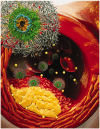Targeting and therapeutic peptides in nanomedicine for atherosclerosis
- PMID: 27022138
- PMCID: PMC4871742
- DOI: 10.1177/1535370216640940
Targeting and therapeutic peptides in nanomedicine for atherosclerosis
Abstract
Peptides in atherosclerosis nanomedicine provide structural, targeting, and therapeutic functionality and can assist in overcoming delivery barriers of traditional pharmaceuticals. Moreover, their inherent biocompatibility and biodegradability make them especially attractive as materials intended for use in vivo In this review, an overview of nanoparticle-associated targeting and therapeutic peptides for atherosclerosis is provided, including peptides designed for cellular targets such as endothelial cells, monocytes, and macrophages as well as for plaque components such as collagen and fibrin. An emphasis is placed on recent advances in multimodal strategies and a discussion on current challenges and barriers for clinical applicability is presented.
Keywords: Peptides; atherosclerosis; biomaterial; inflammation; micelles; nanoparticles.
© 2016 by the Society for Experimental Biology and Medicine.
Figures



Similar articles
-
How Advanced Is Nanomedicine for Atherosclerosis?Int J Nanomedicine. 2025 Mar 17;20:3445-3470. doi: 10.2147/IJN.S508757. eCollection 2025. Int J Nanomedicine. 2025. PMID: 40125442 Free PMC article. Review.
-
Molecularly targeted nanomedicine enabled by inorganic nanoparticles for atherosclerosis diagnosis and treatment.Adv Drug Deliv Rev. 2023 Mar;194:114709. doi: 10.1016/j.addr.2023.114709. Epub 2023 Jan 20. Adv Drug Deliv Rev. 2023. PMID: 36690300 Review.
-
Perspectives and opportunities for nanomedicine in the management of atherosclerosis.Nat Rev Drug Discov. 2011 Oct 21;10(11):835-52. doi: 10.1038/nrd3578. Nat Rev Drug Discov. 2011. PMID: 22015921 Free PMC article. Review.
-
High-density lipoprotein mimetic nano-therapeutics targeting monocytes and macrophages for improved cardiovascular care: a comprehensive review.J Nanobiotechnology. 2024 May 17;22(1):263. doi: 10.1186/s12951-024-02529-x. J Nanobiotechnology. 2024. PMID: 38760755 Free PMC article. Review.
-
Macrophage-targeted nanomedicine for the diagnosis and treatment of atherosclerosis.Nat Rev Cardiol. 2022 Apr;19(4):228-249. doi: 10.1038/s41569-021-00629-x. Epub 2021 Nov 10. Nat Rev Cardiol. 2022. PMID: 34759324 Free PMC article. Review.
Cited by
-
Therapeutic Response of miR-145 Micelles on Patient-Derived Vascular Smooth Muscle Cells.Front Digit Health. 2022 Jun 15;4:836579. doi: 10.3389/fdgth.2022.836579. eCollection 2022. Front Digit Health. 2022. PMID: 35783597 Free PMC article.
-
Transdermal Delivery of Kidney-Targeting Nanoparticles Using Dissolvable Microneedles.Cell Mol Bioeng. 2020 Jun 1;13(5):475-486. doi: 10.1007/s12195-020-00622-3. eCollection 2020 Oct. Cell Mol Bioeng. 2020. PMID: 33184578 Free PMC article.
-
Synthesis of Monocyte-targeting Peptide Amphiphile Micelles for Imaging of Atherosclerosis.J Vis Exp. 2017 Nov 17;(129):56625. doi: 10.3791/56625. J Vis Exp. 2017. PMID: 29286384 Free PMC article.
-
Stem cell-derived exosome delivery systems for treating atherosclerosis: The new frontier of stem cell therapy.Mater Today Bio. 2024 Dec 30;30:101440. doi: 10.1016/j.mtbio.2024.101440. eCollection 2025 Feb. Mater Today Bio. 2024. PMID: 39866781 Free PMC article. Review.
-
Shape Effects of Peptide Amphiphile Micelles for Targeting Monocytes.Molecules. 2018 Oct 27;23(11):2786. doi: 10.3390/molecules23112786. Molecules. 2018. PMID: 30373234 Free PMC article.
References
-
- Mozaffarian D, Benjamin EJ, Go AS, Arnett DK, Blaha MJ, Cushman M, de Ferranti S, Després JP, Fullerton HJ, Howard VJ, Huffman MD, Judd SE, Kissela BM, Lackland DT, Lichtman JH, Lisabeth LD, Liu S, Mackey RH, Matchar DB, McGuire DK, Mohler ER, Moy CS, Muntner P, Mussolino ME, Nasir K, Neumar RW, Nichol G, Palaniappan L, Pandey DK, Reeves MJ, Rodriguez CJ, Sorlie PD, Stein J, Towfighi A, Turan TN, Virani SS, Willey JZ, Woo D, Yeh RW, Turner MB. Heart disease and stroke statistics—2015 update: a report from the American heart association. Circulation 2014; 129: e28–292. - PubMed
-
- National Heart Lung Blood Institute. What is atherosclerosis? National Institute of Health, Bethesda, MD, 2015.
-
- Staff MC. Arteriosclerosis/atherosclerosis. Mayo Clinic, Mayo Foundation for Medical Education and Research, Rochester, MN, 1998–2015.
-
- American Heart Association. What is cardiovascular disease? American Heart Association, Inc, Dallas, TX, 2014.
Publication types
MeSH terms
Substances
Grants and funding
LinkOut - more resources
Full Text Sources
Other Literature Sources

